Animal identification
Animal identification using a means of marking is a process done to identify and track specific animals. It is done for a variety of reasons including verification of ownership, biosecurity control, and tracking for research or agricultural purposes.
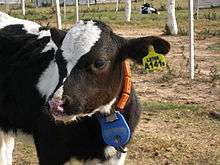
History
Individual identification of animals by means of body markings has been practiced for over 3,800 years, as stated in Code of Hammurabi.[1] The first official identification systems are documented as far as the 18th century. In Uruguay for instance maintained at that time a register of hot brands.[2]
Methods
Birds
- Leg rings
- Wing tags
- Microchip implants (parrots)
- Telemetry (falconry birds)
Sheep
- Freeze branding
- Branding (hot-iron)
- Collar
- Earmarking
- Ear tags (non-electronic)
- Ear tags (electronic)
- Semi-permanent paint
Pigs
Horses
- Collars (non-electronic)
- Branding (hot-iron)
- Branding (freeze)
- Microchip implants
- Lip tattoo
Cattle
Dogs
- Collar
- Microchip implants
- Tattoo
Laboratory mice
- Earmarking (notching or punching)
- Ear tags (nickel, copper or scannable 2D barcode tags)
- Microchip implants
- Hair dye
- Toe clipping[note 1]
- Manual tattoos (tail, foot pad or ears)
- Automated tail tattoos[3]
Fish
- Microchip implants
- Fin clipping
- Coded wire tag
- Passive integrated transponder
- Acoustic tag
- Visible implant elastomer (VIE)
Marine mammals
- Transponders
- Adhesive tags
Amphibians
- Microchip implants
- Toe clippings
- Passive integrated transponder
- Visible implant elastomer (VIE)[4]
Invertebrates
- Adhesive tags
- Semi-permanent paint
National animal identification schemes
- British Cattle Movement Service in Britain
- National Animal Identification and Tracing in New Zealand
- National Animal Identification System in the United States
- National Livestock Identification System in Australia
Footnotes
- 'Toe clipping' in mice involves the full or partial amputation of one or more digits as a means of permanent identification.
Gallery
- Great frigatebird with a wing tag
 Bird ring
Bird ring Sheep with an earmark
Sheep with an earmark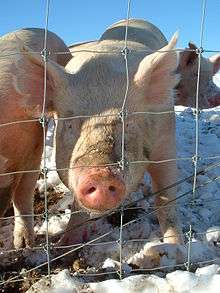 Pig with earmark
Pig with earmark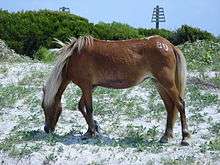 Horse with a brand
Horse with a brand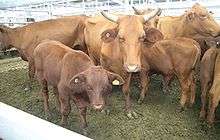 Santa Gertudis cattle with electronic and non-electronic ear tags
Santa Gertudis cattle with electronic and non-electronic ear tags Calf with a non-electronic ear tag, numbered collar and transponder (blue device)
Calf with a non-electronic ear tag, numbered collar and transponder (blue device) Bear with an ear tag and transponder
Bear with an ear tag and transponder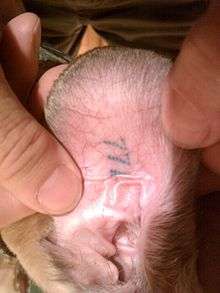 Tattoo inside a Greyhound's ear
Tattoo inside a Greyhound's ear Dog collar with dog license and other dog tags
Dog collar with dog license and other dog tags A microchip implant and applicator
A microchip implant and applicator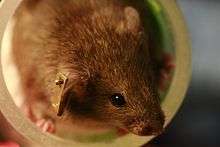 A laboratory mouse with an ear tag
A laboratory mouse with an ear tag Fish with a transponder
Fish with a transponder Harbour seal with a transponder
Harbour seal with a transponder Common seal with an adhesive tag
Common seal with an adhesive tag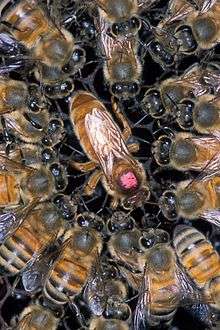 Africanised honeybee with a paint spot
Africanised honeybee with a paint spot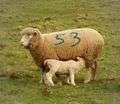 Sheep with painted number
Sheep with painted number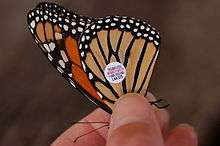 Monarch butterfly tagged with a sticker
Monarch butterfly tagged with a sticker.jpg) Mussels being tagged
Mussels being tagged
gollark: Denied.
gollark: Either a good cryptographic hash or a fast noncryptographic one.
gollark: Also, it isn't 20 bytes. That isn't a power of two so nobody likes it.
gollark: Why SHA1?
gollark: <#348702212110680064> is implicitly self-derailed.
References
- Blancou, J (2001). "A history of the traceability of animals and animal products". Revue scientifique et technique (International Office of Epizootics). 20 (2): 413–25. PMID 11548516.
- http://www.allflex-group.com/front-offices/anglais/119-the_history_of_livestock_identification.aspx?idparentnode=120
- Bell, J. "Labstamp system" (PDF). Archived from the original (PDF) on February 26, 2015. Retrieved February 26, 2015.
- Fouilloux, Chloe; Garcia-Costoya, Guillermo; Rojas, Bibiana. "Visible Implant Elastomer (VIE) Success in Early Larval Stages of a Tropical Amphibian Species". PeerJ. doi:10.7717/peerj.9630.
| Wikimedia Commons has media related to Animal identification. |
This article is issued from Wikipedia. The text is licensed under Creative Commons - Attribution - Sharealike. Additional terms may apply for the media files.